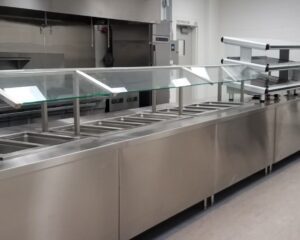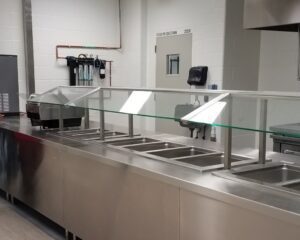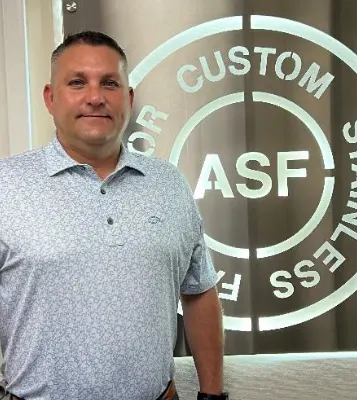If you’re responsible for managing a commercial kitchen, you’ll swiftly uncover that refrigerated drop in wells are crucial yet frequently disregarded components of your operation. These indispensable units keep your ingredients fresh and safe while allowing easy access during prep and service. However, without proper maintenance, they can become energy-sapping liabilities that put food safety at risk and lead to costly repairs. Whether you’ve just installed new wells or want to prolong the life of existing units, understanding the critical maintenance practices will help you prevent common issues and maintain ideal performance. Let’s explore the essential steps you need to take.
Daily Cleaning Procedures
Pay special attention to the drain line, clearing it of any debris to prevent clogs and guarantee proper condensation drainage. This step is vital for ideal storage organization and preventing water accumulation.

Once you’ve completed the cleaning process, thoroughly dry all surfaces with a clean cloth before returning the unit to service. This prevents water from diluting food contents and upholds the well’s effectiveness.
Remember to document all cleaning procedures as part of your daily maintenance routine to certify consistent food safety compliance.
Temperature Control Guidelines
To guarantee food safety compliance, keep your refrigerated drop in wells within a temperature range of 33°F to 41°F while maintaining proper refrigeration. Start by implementing temperature data logging systems to track daily fluctuations, which will help you identify patterns and potential issues before they become critical problems.
Check your temperature sensor positioning regularly to verify accurate readings. The sensor should be properly located within the evaporator area, as incorrect placement can lead to false readings and compromise food safety. You’ll want to establish temperature mapping procedures to identify hot spots or cold zones within your refrigerated drop in wells, allowing for more precise temperature control adjustments.
Install temperature alarm systems to alert you when temperatures fall outside the acceptable range. This becomes especially important during periods of heavy usage or when ambient temperatures fluctuate dramatically. To maximize energy efficiency strategies, monitor and adjust your settings based on room temperature, door opening frequency, and food load. You’ll need to make frequent adjustments during busy service periods when the refrigerated drop in wells are accessed more often, helping maintain consistent temperatures while optimizing energy consumption.
Coil and Fan Maintenance
Regular maintenance of coils and fans directly impacts your drop-in well’s temperature performance. You must implement consistent coil condition monitoring and fan motor assessment procedures to guarantee optimal operation. Check your evaporator and condenser coils monthly for dirt, debris, or ice buildup that could restrict airflow and reduce efficiency.
Start cleaning your evaporator coil by disconnecting the power and using a soft brush to remove loose debris. Then, apply an approved coil cleaner and rinse thoroughly to ensure proper drainage.
For condenser coil maintenance, use compressed air or a vacuum to remove dust and debris from the external fins, working from the inside out to prevent debris from pushing further into the coils.
Listen for unusual noises during your fan motor assessment and check for smooth operation. You should inspect fan blades for damage or misalignment and verify proper rotation. Don’t forget to incorporate refrigerant leak detection into your maintenance routine – check all connections and coils with an electronic leak detector, paying special attention to joints and fittings. If you detect any leaks, contact a certified technician immediately to prevent system damage and maintain proper cooling performance.
Gasket Care and Replacement
When performing gasket cleaning methods, use mild detergents and soft cloths to remove grease, food particles, and other debris that can compromise the seal. Don’t use abrasive cleaners or tools that could damage the gasket material.
If you notice signs of gasket failure diagnostics, such as cracking, warping, or hardening, you’ll need to replace the gasket immediately. Proper gasket material selection is essential during replacement—always use manufacturer-recommended parts to guarantee compatibility and ideal sealing.
Follow precise gasket installation techniques, including proper alignment and even pressure distribution around the seal. You’ll want to test the seal by closing the door on paper – if it slides easily, the gasket needs adjustment or replacement. Remember that well-maintained gaskets directly impact your unit’s energy efficiency and temperature stability.
Drain System Upkeep
A refrigerated well’s drain system demands consistent attention to prevent costly maintenance issues and potential food safety concerns. To guarantee proper operation, you must implement regular drainage pipe inspection procedures and maintain vigilant oversight of your unit’s water flow optimization.

To prevent clogging, you’ll want to clear the drain regularly and examine all connections for potential issues. Effective clogging prevention methods include using a drain snake or compressed air to remove debris buildup that could restrict water movement. Don’t forget to inspect the drain cover maintenance, ensuring it’s properly seated and free from damage that could allow large debris to enter the system.
Your chemical treatment options include periodic cleaning with diluted vinegar or bleach to eliminate bacteria and sanitize the drainage system. When performing these treatments, you’ll want to ensure complete solution flushing through all drain lines. Position your drain at the correct angle to optimize water flow and prevent standing water accumulation. Regular inspection of drain line connections will help you identify cracks, leaks, or obstructions early, allowing for prompt repairs before they develop into significant problems.
Proper Loading Techniques
Proper loading of refrigerated drop in wells directly impacts their cooling efficiency and food safety performance. To achieve preferred airflow optimization, you must maintain specific pan configuration strategies that allow proper circulation throughout the unit. When positioning your food items, leave adequate space between containers and the well’s walls to maintain consistent temperature gradient monitoring.
Your shelf placement positioning should follow a systematic approach. Don’t stack or pile containers on each other, which creates barriers restricting crucial airflow. Instead, distribute your food items evenly across the pans, implementing food item arrangement techniques that maximize visibility and accessibility. This strategic placement reduces the frequency of well openings, helping maintain stable temperatures.
Avoid overloading the well, as this common mistake can drastically compromise cooling efficiency. When arranging pans, ensure they’re positioned to allow air to flow freely around them. Monitor your temperature gradient regularly to verify that your loading configuration isn’t creating hot spots or cooling dead zones. By following these precise loading techniques, you’ll maintain preferred performance and extend your unit’s operational lifespan.
Seasonal Deep Cleaning Protocol
Seasonal deep cleaning protocols require precise execution to maintain your refrigerated drop-in well’s ideal performance. As part of your seasonal inspection schedule, you must completely disassemble the unit according to manufacturer specifications, ensuring each component receives thorough attention.
Begin by organizing your storage compartment and removing all components that can be detached. Clean each part painstakingly using appropriate cleaning solutions, paying special attention to the pan, drainage system, and interior surfaces. While the unit is disassembled, examine the lighting system optimization potential and consider an interior layout redesign if needed. Don’t forget to inspect gaskets and door seals, replacing any that show signs of wear or damage.
Focus on the condenser coil and fan assembly, using a soft-bristle brush and compressed air to remove accumulated debris. This step is indispensable for maintaining efficient heat dissipation. To maximize efficiency, consider customizing the shelving configuration during reassembly. Once thoroughly cleaned and inspected all components, reassemble the unit cautiously. Perform a detailed functional test to verify proper temperature maintenance and operation before returning the well to service.
Emergency Troubleshooting Steps
Quick response times during equipment malfunctions can prevent costly food waste and maintain critical temperature control in refrigerated drop in wells. When facing a power failure response, immediately transfer food items to backup refrigeration and document the outage duration.
If you’re experiencing unexpected temperature fluctuations, check the thermostat settings, guarantee proper airflow around the unit, and verify that gaskets are sealing correctly.
Before attempting startup diagnostics, conduct electrical safety checks by examining power cords for damage and ensuring proper voltage supply to the unit. Don’t skip inspecting circuit breakers and fuses.

Listen for unusual noises when troubleshooting the compressor, check for proper cycling, and monitor oil levels if accessible. If the compressor isn’t starting, verify the start relay and capacitor function correctly.
You’ll need to evaluate whether the issue requires immediate professional intervention. Contact a certified technician immediately if you notice refrigerant leaks, electrical burning smells, or persistent temperature control problems. Meanwhile, maintain a detailed log of all symptoms, timing of issues, and any temporary solutions you’ve implemented to assist with diagnosis and repair.
Ensuring Longevity and Efficiency with Refrigerated Drop In Wells
Maintaining refrigerated drop in wells is an investment in your commercial kitchen’s success. From daily cleaning and temperature monitoring to seasonal deep cleaning and troubleshooting, these best practices ensure your equipment performs optimally for years to come. Partnering with a trusted provider for custom solutions can further enhance your kitchen’s efficiency and durability.
For over 50 years, All Southern Fabricators has been a trusted leader in stainless steel fabrication for the food service industry. Known for crafting high-quality, long-lasting products, ASF offers custom solutions tailored to meet the unique needs of commercial kitchens. Whether you’re looking for durable equipment, expert installation, or responsive service, their team is committed to excellence.
Ready to improve your kitchen efficiency? Call All Southern Fabricators today at (800) 878-2732 or visit allsouthern.tempurl.host to explore their offerings and find the perfect solution for your business needs.

